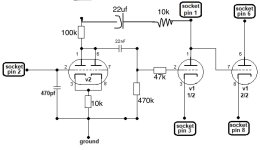Yes yes I am really very happy because it worked and especially with your help. I measured the gain in decibels, it has extra pre-amplification and it is at 32db.. Of course I would like something more, so I thought since I have an extra triode. Use it properly.
Just take care of what you experienced if you want 3 gain stages + CF in a small box: oscillations.
By now you are having lower gain than expected because you are wasting part of the paralleled stages through the feedback anode-to-anode with the following stage.
Which kind of sound do you want to get? I can help you more if you have a reference in mind.
By now you are having lower gain than expected because you are wasting part of the paralleled stages through the feedback anode-to-anode with the following stage.
Which kind of sound do you want to get? I can help you more if you have a reference in mind.
Mainly I don't mind being bothered. Anyway, I like suffering and I learn things from mistakes. Now for what sound I want, For example the sound of this amplifier I like very much, it's warm and bright, it just needs more gain db, for modern metal, I use a booster pedal of my own construction .. clean booster, I've relied on it enough on the mxr micro amp. not the ts9-ds1-t808 and all those with diode clipping.so I'm thinking of splitting these 2 parallel triodes and getting a gain of around 20-25 db gain from each one
Instrument amplification it's not dB amplification per se, but more a shape of frequencies and harmonics to be amplified downstream.
I'd go for something like 100k 10k, 220k 2.2k, 220k 2.7k then CF. Attenuation and frequency shape to be determined.
I'd go for something like 100k 10k, 220k 2.2k, 220k 2.7k then CF. Attenuation and frequency shape to be determined.
Sorry … I don’t make some change on this 2 triodes , only on the extra triode ,, let me ask you something else, do I like having high output impedance? or low, on the parallel triodes, because if I want less I have to separate the triodes. Am I talking good or nonsense?
Not much sense. All high-gain amps have one single triode for gain stage, not two paralleled (except some RIvera).
One per stage is enough, the problem as I was saying is too much gain in a small enclosure.
One per stage is enough, the problem as I was saying is too much gain in a small enclosure.
Look ,, I want more gain, meaning more saturation. in order for this adapter to be considered worthy to be inserted into the amplifier.. I'm thinking of splitting the parallel triode and making 2 gain stages instead of an extra,, but not as aggressive as the parallel triode, but something like - 100K 10k and 100 4.7k and maybe with a bypass cap .,,, be more weak compared to the original parallel but in the series to give something more in gain / saturation,
Take a look at how the 5150 has the gain stages structured.
Consider his last stage as a CF in your schematic.
Consider his last stage as a CF in your schematic.
Which 5150? Peavy - fender - evh? I’m jokin of course is the peavyTake a look at how the 5150 has the gain stages structured.
Consider his last stage as a CF in your schematic.
really it's as close as I can get to the sound I want .. as for the changes I made to the parallel triode are the following :
156k plate resistor - 8.2k cathode resistor and bypass with 330Nf … the sound is amazing !! It’s very chugging! with these changes there is no oscillation at all and also i haven't messed with anything other than the other 2 triodes .. i want to do some more tests though ,,,
156k plate resistor - 8.2k cathode resistor and bypass with 330Nf … the sound is amazing !! It’s very chugging! with these changes there is no oscillation at all and also i haven't messed with anything other than the other 2 triodes .. i want to do some more tests though ,,,
Bud luck , on low master volume works great but when turn the volume up the oscillation rise again ,, this is happen from bypass cap
It’s not bad luck, it’s positive feedback: now you have two stages in phase. Let me sketch you another solution with two stages in series.
Ufffffff … I’m sooo confused.. I waiting for your sketch … by the way without bypas cap work great on high volume but the gain it’s not big
So, it's too late to sketch and scan it now.
I'll try to resume here, tell me if it's clear for you:
I'll try to resume here, tell me if it's clear for you:
- add a 10k 22u PSU node from the CF node, to supply the two added stages;
- keep the 470p to ground, then first stage 100k 10k with a 470p snubber;
- 22n to 470k to 47k to ground (to be chechek based on your preferences);
- 100k grid stopper to 220k 2k2;
- 22n to 470k to 47k to ground (to be chechek based on your preferences);
- Keep the last two stages as standard.
- Home
- Live Sound
- Instruments and Amps
- Soldano hot mod v2 on oscilloscope
